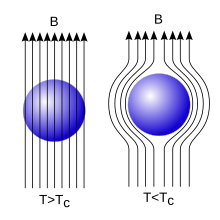Superdiamagnetism
| Condensed matter physics |
|---|
 |
Superdiamagnetism (or perfect
Superdiamagnetism established that the superconductivity of a material was a stage of phase transition. Superconducting magnetic levitation is due to superdiamagnetism, which repels a permanent magnet which approaches the superconductor, and flux pinning, which prevents the magnet floating away.
Superdiamagnetism is a feature of superconductivity. It was identified in 1933, by Walther Meissner and Robert Ochsenfeld, but it is considered distinct from the Meissner effect which occurs when the superconductivity first forms, and involves the exclusion of magnetic fields that already penetrate the object.

Theory
"Screening currents" also appear in a situation wherein an initially normal, conducting metal is placed inside a magnetic field. As soon as the metal is cooled below the appropriate transition temperature, it becomes superconducting. This expulsion of magnetic field upon the cooling of the metal cannot be explained any longer by merely assuming
See also
- Superfluidity
- Timeline of low-temperature technology
References
- Shachtman, Tom, Absolute Zero: And the Conquest of Cold. Houghton Mifflin Company, December 1999. ISBN 0-395-93888-0

